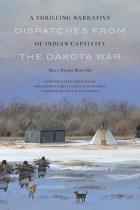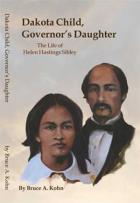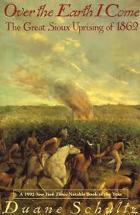|
|
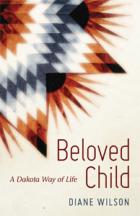
Beloved Child: A Dakota Way of Life
|
Beloved Child: A Dakota Way of Life
Sustained by rich traditions, ceremonies, advocacy, and education, Dakota families are transforming the legacy of colonization and assimilation into a better way of life for their children.
Buy Book
|
|
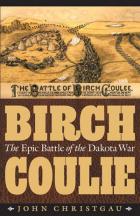
Birch Coulie: The Epic Battle of the Dakota War
|
Birch Coulie: The Epic Battle of the Dakota War
In the days following the Battle of Birch Coulie, the decisive battle in the deadly Dakota War of 1862, one of President Lincoln’s private secretaries wrote: “There has hardly been an outbreak so treacherous, so sudden, so bitter, and so bloody, as that which filled the State of Minnesota with sorrow and lamentation.” Even today, at the 150th anniversary of the Dakota War, the battle still raises questions and stirs controversy. In Birch Coulie John Christgau recounts the dramatic events surrounding the battle. American history at its narrative best, his book is also a uniquely balanced and accurate chronicle of this little-understood conflict, one of the most important to roil the American West.
Christgau’s account of the war between white settlers and the Dakota Indians in Minnesota examines two communities torn by internal dissent and external threat, whites and Native Americans equally traumatized by the short and violent war. The book also delves into the aftermath, during which thirty-eight Dakota men were hanged without legal representation or the appearance of defense witnesses, the largest mass execution in American history. With its unusually nuanced perspective, Birch Coulie brings a welcome measure of clarity and insight to a critical moment in the troubled history of the American West.
John Christgau, an award-winning writer on issues of restitution and reconciliation, is the author of several books, including Enemies: World War II Alien Internment. _University of Nebraska Press
Buy Book
|
|

Brackett’s Battalion: Minnesota Cavalry in the Civil War and Dakota War
|
Brackett’s Battalion: Minnesota Cavalry in the Civil War and Dakota War
Amidst the chaos of a two-front war — one against the Confederacy and the other against the Dakota Indians — Brackett’s Battalion of Minnesota Cavalry transformed from raw recruits into seasoned and battle-hardened troops and served longer than any other Minnesota unit in the Civil War.
After two years in the Southern theater of the Civil War, Brackett’s Battalion became part of the Northwestern Indian Expedition of 1864 and rode into Dakota Territory to seek out and engage the Indians in response to the attacks on settlers in Minnesota. On July 28, 1864, during a decisive battle against a large Dakota contingent at Killdeer Mountain, Brackett’s men conducted a remarkable three-mile-long saber charge that resulted in vicious hand-to-hand combat and eventually turned the tide of the battle.
Told through the extant journals, diaries, and letters of the troopers themselves, Brackett’s Battalion brings to light a long neglected aspect of Minnesota’s role in the Civil War and reveals a side of the conflict rarely portrayed in the war’s literature.
Kurt D. Bergemann has long been a student of the Civil War. This book is a result of his research on his great-great-grandfather, who served in Brackett’s Battalion.
Praise for Brackett’s Battalion
“The Minnesota cavalrymen of Brackett’s Battalion fought against the Confederates in the South and in the bloody battles against the Dakota. This is an important and first-rate book of a story long obscured.” — Lance J. Herdegen, author of The Men Stood Like Iron: How the Iron Brigade Won Its Name
Buy Book
|
|

Camera and Sketchbook: Witnesses to the Sioux Uprising of 1862
|
Camera and Sketchbook: Witnesses to the Sioux Uprising of 1862
Volunteer soldiers Adrian J. Ebell (1840-1877), a pioneering photojournalist, and Albert Colgrave (1839-1863), a professional graphic artist, tell their own versions of the war in words and images.
Unique, eyewitness accounts of the Sioux Uprising that swept across southwestern Minnesota in August 1862, when the federal government failed to pay annuities to starving Sioux (Dakota) Indians. This catastrophic war left a trail of death and destruction and many stories about what happened.
Compilers and editors Alan R. Woolworth and Mary H. Bakeman contribute an invaluable context for this remarkable collection, with biographical sketches of Ebell and Colgrave; texts of Ebell's articles based on interviews with white, Indian, and mixed-blood Dakota participants; reproductions of Ebell's photographs, Colgrave's unique sketches (many never before published), and the engravings made from them used to illustrate Ebell's Harper's New Monthly Magazine article; authoritative lists of white captives held by the Dakotas in early September, 1862, and the white casualties of the Battle of Birch Coulee; a bibliography; and a full index.
|
|
|
|
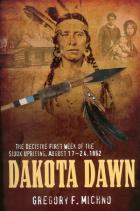
Dakota Dawn: The Decisive First Week of the Sioux Uprising, August 17-24, 1862
|
Dakota Dawn: The Decisive First Week of the Sioux Uprising, August 17-24, 1862
The author's research includes select secondary studies and 2,000 pages of primary sources including recollections, original records, diaries, newspaper accounts, and other archival records. His use of the Indian Depredation Claim files paints a firsthand slice of the life of a frontier people, their cabins, tools, clothes, crops, animals, and cherished possessions. Many of these claims have never been incorporated into a book; Michno’s use of them allows him to more fully expound on various episodes and correct previous misconceptions.
Richly illustrated with 42 contemporary and modern photos and illustrations and accompanied by 19 original maps.
Buy Book
|
|
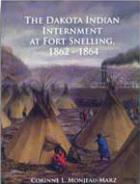
Dakota Indian Internment at Fort Snelling, 1862-1864
|
Dakota Indian Internment at Fort Snelling, 1862-1864
Author Corinne L. Monjeau-Marz has gathered and interpreted a massive amount of data to write a factual, objective account of the internment camp and the experiences of its unfortunate inhabitants. Her book will help to shed new light on this controversial camp and the effects it had on those who lived there from 1862 to 1864.
The Dakota Indian War swept southwestern Minnesota in August, 1862. Hundreds of white settlers and Dakota Indians were killed. In six short weeks, fighting ended and some defeated Dakotas fled to the western prairies, others surrendered. As a result of this conflict nearly 400 Dakotas were tried and 303 men sentenced to death. After intervention by President Lincoln, 38 Dakota men were executed at Mankato, Minnesota on December 26, 1862. At the same time, sixteen hundred Dakota women, children, and old men were detained at Fort Snelling, Minnesota. Their society and traditions had been shattered. Living conditions were poor and virulent diseases struck the camp, killing hundreds of them.
Author Corinne L. Monjeau-Marz has gathered and interpreted a massive amount of data to write a factual, objective account of the internment camp and the experiences of its unfortunate inhabitants. Her book will help to shed new light on this controversial camp and the effects it had on those who lived there from 1862 to 1864.
Buy Book
|
|
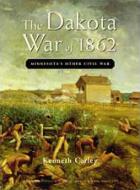
Dakota War of 1862
|
Dakota War of 1862
The most accessible and balanced account available, The Dakota War of 1862 draws on a wealth of written and visual materials by white and Indian participants and observers to show the sources of the Dakotas' justified and bitter wrath — and the terrible consequences of the conflict.
While the Civil War raged in the East and South, Dakota Indians in Minnesota erupted violently into action against white settlers, igniting the tragic Dakota War of 1862. Hemmed in on a narrow reservation along the upper Minnesota River, the Dakota (Sioux) were frustrated by broken treaties, angered by dishonest agents and traders, and near starvation because of crop failures and late annuity payments.
Led by Little Crow, Dakota warriors attacked the Redwood and Yellow Medicine Indian agencies and all whites living on their former lands in southwestern Minnesota. They killed more than 450 whites and took some 250 white and mixed-blood prisoners during the 38-day conflict. White civilians and military units commanded by Henry H. Sibley defended towns and forts, pursued warriors, and eventually forced the Indians to surrender or flee westward. The penalties imposed by vengeful whites were swift and devastating. The federal government hanged 38 Dakota men in the largest mass execution in U.S. history, 300 were imprisoned, and the Dakota people were banished from the state.
Previously published under the title The Sioux Uprising of 1862 (ISBN 0-87351-392-4).
Praise for The Dakota War of 1862
"A balanced, judicious and objective account." — Annals of Wyoming
"An objective, readable account … interspersed with excellent maps, sketches, and photographs, all of which provide a fascinating portrayal of the conflict." — North Dakota Quarterly
"This handsome book is highly recommended." — Minneapolis Tribune
Buy Book
|
|
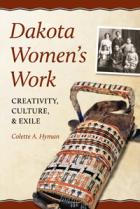
Dakota Women's Work: Creativity, Culture, and Exile
|
Dakota Women's Work: Creativity, Culture, and Exile
Examines how the decorative work of Dakota women — and the changes in that work — embodies the culture, spirit, and history of the Dakota people.
A tiny pair of beaded deerskin moccasins, given to a baby in 1913, provides the starting point for this thoughtful examination of the work of Dakota women. Mary Eastman Faribault, born in Minnesota, made them almost four decades after the U.S.–Dakota War of 1862. This and other ornately decorated objects created by Dakota women — cradleboards, clothing, animal skin containers—served more than a utilitarian function. They tell the story of colonization, genocide, and survival.
Author Colette Hyman traces the changes in the lives of Dakota women, starting before the arrival of whites and covering the fur trade, the years of treaties and shrinking lands, the brutal time of removal, starvation, and shattered families after 1862 — and then the transition to reservation life, when missionaries and government agents worked to turn the Dakota into Christian farmers. The decorative work of Dakota women reflected all of this: native organic dyes and quillwork gave way to beading and needlework, items traditionally decorated for family gifts were produced to sell to tourists and white collectors, work on cradleboards and animal skin bags shifted to the ornamenting of hymnals and the creation of star quilts.
Through it all, the work of Dakota women proclaims and retains Dakota identity: it is a testament to the endurance of Dakota traditions, to the survival of the Dakota in exile, and — most vividly — to the role of women in that survival.
Colette A. Hyman teaches history and women’s studies at Winona State University. She is the author of Staging Strikes: Workers’ Theatre and the American Labor Movement.
Buy Book
|
|
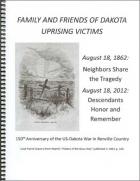
Family and Friends of Dakota Uprising Victims Booklet
|
Family and Friends of Dakota Uprising Victims Booklet
A compilation of settler stories collected by descendants of victims. Includes a map and names of Beaver Creek and Birch Coulie settlers, and 32 stories of Renville County uprising victims. Renville County Pioneers and Renville Rangers are also covered in the booklet, along with today’s descendants’ relationships in Birch Coulie and Beaver Falls Township.
|
|
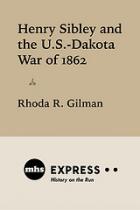
Henry Sibley and the U.S.-Dakota War of 1862
|
Henry Sibley and the U.S.-Dakota War of 1862
Henry Hastings Sibley was treaty negotiator, state governor, and military leader, and his life intersected with the many complexities and crises of nineteenth-century America, including the U.S.-Dakota War of 1862. Rhoda R. Gilman, who exhaustively researched Sibley’s life, outlines the events and actions leading up to and following the war, and Sibley’s role in it.
This e-book short highlights the rifts and crises leading up to the U.S.-Dakota War in Minnesota between the Dakota people and the U.S. government, as keenly represented by then governor and later militia leader, Henry Sibley. Excerpted from the book, Henry Hastings Sibley: Divided Heart.
Rhoda Gilman is also the author of Stand Up! The Story of Minnesota’s Protest Tradition and a founding member of Women Historians of the Midwest and a former candidate for lieutenant governor of Minnesota on the Green Party ticket.
Henry Sibley and the U.S.-Dakota War of 1862 is the is the second release from MNHS Express, the new digital imprint from the Minnesota Historical Society Press (MNHS Press) of short-form e-books. Be they essays from published works or forthcoming titles or original pieces, MNHS Express e-books present quick reads on relevant and compelling topics.
Buy Book
|
|
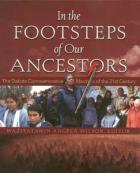
In the Footsteps of Our Ancestors
|
In the Footsteps of Our Ancestors
In the Footsteps of Our Ancestors tells stories of the Dakota Commemorative Marches, both past and present, in words and images from the participants.
November 7, 1862, was the beginning of a brutal forced march of Dakota women, children, and elders that took them 150 miles from the Lower Sioux Agency to Fort Snelling in Minnesota. There they were interred for the winter before being transported from their homeland. Many of them did not survive.
In November of 2002 and again in 2004, Dakota people from the U.S. and Canada commemorated this painful journey by again walking the route of their ancestors. For the Dakota, the Commemorative March is an opportunity to remember and grieve the suffering endured by their ancestors, as well as to relate a perspective of the event which has rarely been told.
|
|
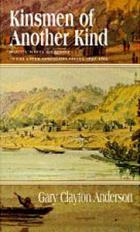
Kinsmen of Another Kind: Dakota-White Relations in the Upper Mississippi Valley, 1650-1862
|
Kinsmen of Another Kind: Dakota-White Relations in the Upper Mississippi Valley, 1650-1862
In August 1862 the Dakota or Eastern Sioux, frustrated at being defrauded by the United States government and at losing their land and livelihood, resorted to armed conflict against the white settlers of southern Minnesota. Gary Clayton Anderson is the first historian to use an ethnohistorical approach to explain why, after more than two centuries of friendly interaction, the bonds of peace between the Dakota and whites suddenly broke apart.
New introduction by the author.
In Kinsmen of Another Kind, Anderson shows how the Dakota concept of kinship affected the tribe's complex relationships with the whites. The Dakota were obligated to help their relatives by any means possible. Traders who were adopted or who married into the tribe gained from this relationship — but had reciprocal responsibilities. After the 1820s, the trade in furs declined, more whites moved into the territory, and the Dakota became more economically dependent on the whites. When American traders and officials failed to fulfill their obligations, many Dakotas finally saw the whites as enemies to be driven from Minnesota.
This reprint edition of Anderson's work, first published in 1984, provides a new understanding of a complicated period in Minnesota history.
In a new introduction, Gary Clayton Anderson, professor of history at the University of Oklahoma, comments on scholarly developments in the field of ethnohistory in the last decade. He is the author of Little Crow, Spokesman for the Sioux and co-editor of Through Dakota Eyes: Narrative Accounts of the Minnesota Indian War of 1862.
Praise for Kinsmen of Another Kind
"This is a thoughtful, well-argued book, soundly based on the relavent primary sources. It is a major contribution to the history of the eastern Sioux." — Reginald Horsman, Journal of American History
"Gary Anderson combines a well-researched narrative of Dakota history until 1862 with a persuasive interpretation of interethnic relations as seen from the Indians' cultural perspective." — Colin G. Calloway, Journal of American Studies
Buy Book
|
|
|
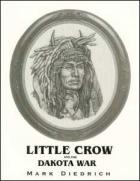
Little Crow and the Dakota War
|
Little Crow and the Dakota War
Little Crow ranks among the prominent American Indian leaders of the 19th century, but his role as a leader in the Dakota War of 1862 has been criticized and questioned by historians. In this book, Mark Diedrich analyzes the motivations behind various historical accounts in an attempt to present an unbiased and accurate picture of the man.
Buy Book
|
|
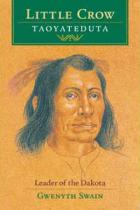
Little Crow: Leader of the Dakota
|
Little Crow: Leader of the Dakota
A compelling biography for young readers that traces the life of the Dakota leader Taoyateduta (Little Crow) and his role in the U.S.-Dakota Conflict of 1862.
Appropriate for readers ages 9 and up.
Borealis Books
The Plains Indian Wars of the nineteenth century garnered enduring fame for certain Indian leaders, their names echoing powerfully even today: Sitting Bull, Crazy Horse, Red Cloud. Just as significant but less often mentioned is Taoyateduta, known to whites as Little Crow, the reluctant leader of Dakota warriors during the U.S.–Dakota War of 1862, the opening salvo of the U.S.–Indian Wars.
In this carefully researched biography of the Dakota leader, the first ever written for children, author Gwenyth Swain presents a compelling portrait of the leader, warrior, and politician at the center of the Dakota War of 1862.
Beginning with Taoyateduta’s childhood along the Mississippi River near present-day St. Paul, this biography explores his life in the Big Woods, his wanderings west from the Mdewakanton Dakota’s traditional home, his leadership of his people when they were forced to sign over their land to white settlers, and his role during the war of 1862. Hemmed in on a narrow reservation, frustrated by broken treaties, angered by dishonest agents and traders, and nearly starved because of crop failures and late annuity payments, Dakota Indians attacked white settlers living on the Indians’ former homelands in southwestern Minnesota. Taoyateduta agreed to lead the battles, knowing that the U.S. government’s response would be swift and terrible. In retribution for the thirty-eight-day war, thirty-eight Dakota men were hanged, thousands were imprisoned, and the Dakota people were expelled from the state.
Taoyateduta’s story brings to life the painful experience of the Dakota as they lost their land and their livelihood — and as some chose to adopt white ways while others fought back, with disastrous consequences. Little Crow: Leader of the Dakota offers a clear and accessible account of both the man who led the Dakota into war and the causes behind that wrenching conflict.
Gwenyth Swain is the author of over twenty books for children, including Dred and Harriet Scott: A Family’s Struggle for Freedom (MNHS Press), the novel Chig and the Second Spread, the picture book I Wonder As I Wander, and Bookworks: Making Books by Hand, winner of a Minnesota Book Award.
Praise for Little Crow
“A clear and sympathetic telling of the life of Little Crow, an important historical figure, and his part in the ‘Great Sioux Uprising.’ A well-told tale of a person and an event in American history that too few have heard about and even fewer have understood. Swain’s story is an excellent starting place for both young and older readers.” — Joseph Bruchac, author of Pocahontas and Sacajawea: The Story of Bird Woman and the Lewis and Clark Expedition
Buy Book
|
|
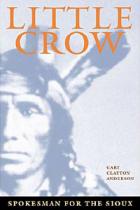
Little Crow: Spokesman for the Sioux
|
Little Crow: Spokesman for the Sioux
"Little Crow" makes a major contribution to our understanding of an Indian tribe that profoundly influenced the course of history in the upper Mississippi Valley, partly at least through the personal role played by its most famous leader." — New Mexico Historical Review
Buy Book
|
|

Minnesota in the Civil and Indian Wars, 1861-1865
|
Minnesota in the Civil and Indian Wars, 1861-1865
Volume I: Narrative and Rosters of Minnesota State Regiments, Companies, and Batteries
Volume II: Official Reports and Correspondence on Battles, Campaigns, Expeditions, Skirmishes
With complete name index
Now available for the first time in nearly a century, this definitive two-volume set details the state’s engagement in the Civil and Dakota Wars as recorded by regimental leaders and their troops.
A handsome and critical addition to the library of every historian, genealogist, and Civil War buff, this rare two-volume set is the official record of Minnesota’s participation in the Civil and Dakota Wars. Published in two parts in the 1890s and written by the men who fought in battle, Minnesota in the Civil and Indian Wars contains regimental rosters (names lists with ages, muster dates, transfers, and remarks) as well as detailed narratives describing the wartime service of each regiment, battery, battalion, and brigade — their marches, campaigns, battles, surrenders, wounded lists, furloughs, reenlistments, and return to Minnesota. Letters, telegrams, and descriptions related to the development of the Dakota War, including dispatches written from the field, offer a personal face to this wartime history.
Included for the first time is a 144-page index to all the regimental rosters, making this an invaluable research tool. Together, these volumes are the essential reference for Minnesota’s troops and their campaigns.
|
|
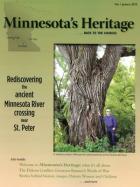
Minnesota's Heritage Issue 1: Rediscovering the ancient Minnesota River crossing near St. Peter
|
Minnesota's Heritage Issue 1: Rediscovering the ancient Minnesota River crossing near St. Peter
Minnesota's Heritage is a journal containing articles on diverse aspects of the development of the state of Minnesota, with emphasis on the broad Minnesota River Valley, and based on objective research and analysis.
Contents
- Introduction. Stephen E. Osman
- Establishing the Site of the Traverse des Sioux near St. Peter. Robert Sandeen
- That Tree is How Old? Todd Nelson
- Visitors to Traverse des Sioux. Robert Sandeen
- The Story of Nancy McClure: Captivity among the Sioux Reprint from the Collections of the Minnesota Historical Society, Vol. VI, 1894
- The Dakota Conflict — A Brief Chronology. Rhoda R. Gilman
- Dakota Women and Children Before and After the Dakota Conflict. Curtis A. Dahlin
- Alexander Ramsey’s Words of War: Opening the Special Session of the Legislature, September 9, 1862. Corinne L. Monjeau-Marz
- Transcript of the Governor Ramsey’s Address
- A Day in Dakota Life (reprint from Dakota Friend, March 1851)
- Three Young Warriors of the 1860s. Stephen E. Osman and Monroe Killy
- MAKING HISTORY: Minnesota Tribal Nations Plaza. Mary H. Bakeman
- The Lives and Influences of the Andrew Robertson Family: Members of the Santee Dakota Indian Metis Community. Alan R. Woolworth
- Remnants of the Past: Tent Peg. Curtis A. Dahlin and Stephen E. Osman
- WHERE IT HAPPENED: The Pond Dakota Mission Park. Jeff Williamson
- PEOPLE OF NOTE: Akipa (Meeting) or Tacandupahotanka and Mazahdewin, Winona (Abigail) Crawford, aka Iron Ring. Alan R. Woolworth
- BOOK REVIEW: Savages & Scoundrels: The Untold Story of America’s Road to Empire Through Indian Territory by Paul VanDevelder. Reviewed by Wesley Hogan
- Index of Names
|
|
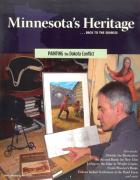
Minnesota's Heritage Issue 2: Painting the Dakota Conflict
|
Minnesota's Heritage Issue 2: Painting the Dakota Conflict
Minnesota's Heritage is a journal containing articles on diverse aspects of the development of the state of Minnesota, with emphasis on the broad Minnesota River Valley, and based on objective research and analysis.
Contents
- Welcome to Minnesota’s Heritage
- Painting the Dakota Conflict. David Geister
- Remnants of the Past: Frank Brawley’s Banjo. W. James Moffet
- Outside the Barricades: The August 23, 1862, Battle for New Ulm. Curtis A. Dahlin
- A Missing Relic of Sibley’s Headquarters. Stephen E. Osman
- Living on Edge in Wright County. Rebecca A. Mavencamp
- My Family’s Flight from Wright County. S.A. Putnam, transcribed by Rebecca A. Mavencamp
- Stories My Grandparents Told Me: Survival of the Spelbrinks: My Milford Pioneer Family. Clara Louise (Spelbrink) Gray
- RESEARCH TIPS: Mazakutemani’s Divorce. Mary H. Bakeman
- Stories Behind Historic Images: Evaluating Sources for Perspective. Mary H. Bakeman
- The St. Peters and Des Moines Rivers: Forgotten Gateways to the Northern Great Plains. Alan R. Woolworth
- The Dakota Indian Settlement at the Gideon Pond Farm 1863–1891. Jeff Williamson
- Gatherings from the Traditional History of the Mdewakantonwan Dakotas, The Dakota Friend, May 1851
- IF YOU GO: Historic Fort Snelling. Stephen E. Osman
- PEOPLE OF NOTE: Henry J. Lasher and Muck-a-pec-wak-kea-zah (“Indian John”). Alan R. Woolworth
- BOOK REVIEW: Little Paul: Christian Leader of the Dakota Peace Party by Mark Diedrich; reviewed by Thomas G. Shaw
- Index
|
|
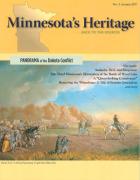
Minnesota's Heritage Issue 3: Panorama of the Dakota Conflict
|
Minnesota's Heritage Issue 3: Panorama of the Dakota Conflict
Minnesota's Heritage is a journal containing articles on diverse aspects of the development of the state of Minnesota, with emphasis on the broad Minnesota River Valley, and based on objective research and analysis.
Contents
- Welcome to Minnesota's Heritage
- You had to be there: Panoramas of the Dakota War. John Isch
- Audacity, Skill, and Firepower: The Third Minnesota's Skirmishers at the Battle of Wood Lake. Stephen E. Osman
- A Small Mystery. Nancy Goodman
- A “Queer-looking Contrivance.” Nancy Goodman
- IF YOU GO: The J.R. Brown Minnesota River Center. Larry Granger
- Removing the Winnebago: A Tale of Frontier Journalism. Chuck Lewis
- ARTIFACTS: Colonel McLaren's Colt Revolver. Dale H. Peterson
- BEHIND THE PHOTO: Clara Sentzke and Her Deceased Daughter, Clara. Curtis A. Dahlin
- PERSONAL STORIES: Unraveling Identities: Notes on John
- Schurch and the Benedict Euni Family. Alan R. Woolworth
- Narrative of Anton Manderfeld, from The History of the Great Massacre by the Sioux Indians in Minnesota by Charles S. Bryant and Abel B. Murch, 1864, translated from the German by Ernest Meyer of St. Peter
- RESEARCH NOTES: Historical CSI: How Many Were Killed at Big Stone Lake? Mary H. Bakeman
- From the Dakota Friend: History of the Dakota People Stories My Grandparents Told Me: Stories of the Poncin Family. Herbert Poncin
- The Rabbit Hunter [Reprint]
- “Russ: Remembering Russell W. Fridley.” Rhoda R. Gilman and Alan R. Woolworth
- PEOPLE OF NOTE: Marguerite Menagre Campbell Patoile and Antoine Scott Campbell. Alan R. Woolworth
- BOOK REVIEW: North Country: The Making of Minnesota by Mary Lethert Wingerd; reviewed by Robert Goodman
|
|
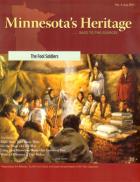
Minnesota's Heritage Issue 4: The Fool Soldiers
|
Minnesota's Heritage Issue 4: The Fool Soldiers
Minnesota's Heritage is a journal containing articles on diverse aspects of the development of the state of Minnesota, with emphasis on the broad Minnesota River Valley, and based on objective research and analysis.
Contents
- Welcome to Minnesota's Heritage
- The Fool Soldiers. Jim Ketcham
- The Fool Soldiers' Story Told Many Ways. Jim Nelson
- Gifts from the Fool Sodliers. Barbara Britain
- Lila Wopila Tanka Heca. Marcella Le Beau
- IF YOU GO: Visiting Dakota War Sites in the Lake Shetek Area. Boll Bolin
- Minnesota on the Verge of Civil War. Hampton Smith
- Using Oral History to Share Our Common Past. Barbara W. Sommer
- What a Difference a Year Can Make: Henry David Thoreau and the Grand Pleasure Excursion of 1861. Corrine Hosfeld Smith
- “An Episode of the American War: An Early Account of the Battle of New Ulm” with reprint of the original article from St. James's Magazine. Daniel John Hoisington
- Looking for Relatives: Select members of the Joseph R. Brown Burial Party. Curtis A. Dahlin
- BEHIND THE PHOTO: She Escaped from the Dakota (Maria Buck). Roger Norland and Curtis A, Dahlin
- RESEARCH NOTES: Finding Online Images. Mary Hawker Bakeman
- Stories My Grandparents Told Me: Peterson Family Stories from Nicollet County, of the Dakota Indian War of 1862. Marlin Peterson
- ARTIFACTS: A Souvenir of the Fort Snelling Internment Camp? Thomas Amble People of Note: David Weston aka Seeing Stone (Tunkanwanyakapi) and Charles H. Mix. Alan R. Woolworth
- BOOK REVIEW: The Assassination of Hole in the Day. Ceceila Mc Keig
|
|
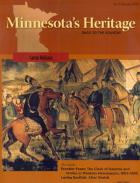
Minnesota's Heritage Issue 5: Camp Release
|
Minnesota's Heritage Issue 5: Camp Release
Minnesota's Heritage is a journal containing articles on diverse aspects of the development of the state of Minnesota, with emphasis on the broad Minnesota River Valley, and based on objective research and analysis.
Contents
- Welcome to Minnesota's Heritage
- The Significance and Challenge of Camp Release, 1862-2012. Alan R. Woolworth
- William Reynolds Brown (1816-1874). Alan R. Woolworh
- A Massacre Averted. Stephen E. Osman
- Prisoners Released: Sibley's Official Report, and List of prisoners released from the St. Paul Pioneer. Alan R. Woolworth
- Perspectives on Camp Release: First-person accounts
- Frontier Fears: The Clash of Dakotas and Whites in the Newspapers of Mankato, Minnesota, 1863-1865. Chuck Lewis
- Lavina Eastlick: After Shetek. John Isch
- Panels from the John Stevens Panorama
- MILITARY: Were There Women in the Ranks? Stephen E. Osman
- MILITARY: Flesh and blood can only stand so much: Doctor Potts examines the recruits. Stephen E. Osman
- Valuable Information to Emigration: Letter to the editor of the St. Paul Pioneer, 1866. General Judson W. Bishop
- BEHINE THE PHOTO: Between Two Worlds, the Ebell photo of Chaska's family. Curtis A. Dahlin
- The Isle of Refuge and News from Monongalia Country. Corinne Monjeau-Marz
- Swedes in Nicollet County. Robert Sandeen
- STORIES: Captivity among the Sioux. Mrs. N.D. White
- ARTIFACT: LaFramboise Blanket. Thomas G. Shaw
- PEOPLE OF NOTE: Itewanyake, James (Look at your Face), a.k.a. "One Armed Jim" and Two Stars, Solomon (We-cah-hpe-no-pah) a.k.a. Solomon Ecetukiye; Dailey, Joseph and Charles M., brothers. Alan R. Woolworth
- BOOK REVIEW: Dakota Dawn, by Gregory F. Michno. Walt Bachman
- Index of Names
|
|
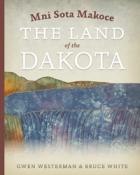
Mni Sota Makoce: The Land of the Dakota
|
Mni Sota Makoce: The Land of the Dakota
Much of the focus on the Dakota people in Minnesota rests on the tragic events of the 1862 U.S.–Dakota War and the resulting exile that sent the majority of the Dakota to prisons and reservations beyond the state’s boundaries. But the true depth of the devastation of removal cannot be understood without a closer examination of the history of the Dakota people and their deep cultural connection to the land that is Minnesota. Drawing on oral history interviews, archival work, and painstaking comparisons of Dakota, French, and English sources, Mni Sota Makoce tells the detailed history of the Dakota people in their traditional homelands for at least hundreds of years prior to exile.
“Minnesota” is derived from the Dakota phrase Mni Sota Makoce, Land Where the Waters Reflect the Clouds — and the people’s roots here remain strong. Authors Gwen Westerman and Bruce White examine narratives of the people’s origins, their associations with the land, and the seasonal round through key players and place names. They consider Dakota interactions with Europeans and offer an in-depth “reading between the lines” of historical documents — some of them virtually unknown — and treaties made with the United States, uncovering misunderstandings and outright deceptions that helped lead to war in 1862.
Dakota history did not begin with the U.S.–Dakota War of 1862 — nor did it end there. Mni Sota Makoce is, more than anything, a celebration of the Dakota people through their undisputed connection to this place, Minnesota, in the past, present, and future.
Gwen Westerman is professor of English and Humanities at Minnesota State University, Mankato. Bruce White is author of We Are at Home: Pictures of the Ojibwe People.
Buy Book
|
|
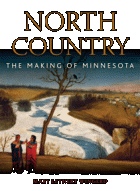
North Country; The Making of Minnesota
|
North Country; The Making of Minnesota
The untold history of how the land of the Dakota and Ojibwe became the State of Minnesota
“In 1862, four years after Minnesota was ratified as the thirty-second state in the Union, simmering tensions between indigenous Dakota and white settlers culminated in the violent, six-week-long U.S.–Dakota War. Hundreds of lives were lost on both sides, and the war ended with the execution of thirty-eight Dakotas on December 26, 1862, in Mankato, Minnesota—the largest mass execution in American history. The following April, after suffering a long internment at Fort Snelling, the Dakota and Winnebago peoples were forcefully removed to South Dakota, precipitating the near destruction of the area’s native communities while simultaneously laying the foundation for what we know and recognize today as Minnesota.
In North Country: The Making of Minnesota, Mary Lethert Wingerd unlocks the complex origins of the state—origins that have often been ignored in favor of legend and a far more benign narrative of immigration, settlement, and cultural exchange. Moving from the earliest years of contact between Europeans and the indigenous peoples of the western Great Lakes region to the era of French and British influence during the fur trade and beyond, Wingerd charts how for two centuries prior to official statehood Native people and Europeans in the region maintained a hesitant, largely cobeneficial relationship. Founded on intermarriage, kinship, and trade between the two parties, this racially hybridized society was a meeting point for cultural and economic exchange until the western expansion of American capitalism and violation of treaties by the U.S. government during the 1850s wore sharply at this tremulous bond, ultimately leading to what Wingerd calls Minnesota’s Civil War.
A cornerstone text in the chronicle of Minnesota’s history, Wingerd’s narrative is augmented by more than 170 illustrations that depict the fascinating, often haunting representations of the region and its inhabitants over two and a half centuries. North Country is the unflinching account of how the land the Dakota named Mini Sota Makoce became the State of Minnesota and of the people who have called it, at one time or another, home.”
Mary Lethert Wingerd is associate professor of history at St. Cloud State University. She is the author of Claiming the City: Politics, Faith, and the Power of Place in St. Paul.
Buy Book
|
|
|
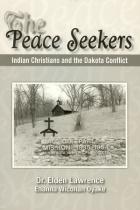
Peace Seekers: Indian Christians and the Dakota Conflict
|
Peace Seekers: Indian Christians and the Dakota Conflict
A thoughtful account of the U.S.-Dakota War of 1862 written by a member of the Sisseton-Wahpeton tribe in South Dakota whose ancestors were driven out of Minnesota after the conflict.
Elden Lawrence is a member of the Sisseton-Wahpeton tribe in South Dakota. His ancestors were driven out of Minnesota after the 1862 conflict, even though they opposed the war and actually helped some settlers escape the bloodshed.
This thoughtful account of the cultural and historical factors that led to the conflict is the result of a quest for his ancestry which he began while working toward a doctorate in sociology at South Dakota State University.
|
|
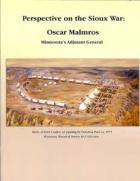
Perspective on the Sioux War
|
Perspective on the Sioux War
Oscar Malmros, Minnesota's Adjutant General, reported twice to the Minnesota Legislature on the military aspects of what he called the Sioux War, better known today as the Dakota Conflict of 1862. In these reprints, he discusses how troops were recruited and dispersed to the frontier, his difficulties in profiding arms and ammunition, and the relationships between the State Militia and the troops recruited for additional service in the South as part of the Union Army. Included are all areas of Minnesota where he assigned troops, from the Minnesota River Valley and Fort Ridgley, to Forts Ripley and Abercrombie and the Red River Valley of the North, and the issues which arose with the Winnebago and Chippewa/Ojibwe tribes. He also identifies each of the local militia units and their officers. In general, he provides an objective framework with which to view reports from his contemporaries for the 1862 events.
Malmros' concise, well-written reports reveal his intelligence and education. He assumed the post of Adjutant General in 1862, and remained in that post for the duration of the Civil War, when he began a series of assignments to various United States consulates around the world. A brief biography and an index are included with his reports.
|
|
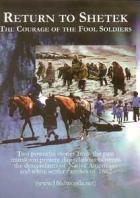
Return to Shetek: The Courage of the Fool Soldiers
|
Return to Shetek: The Courage of the Fool Soldiers
The story of war and captivity in 1862 Minnesota.
In 1862 ten young Lakota men, who became known as the “Fool Soldiers,” rescued Lake Shetek white captives, including two women and six children. Here is their story, told through living descendants of the captives and their rescuers, who met after nearly 150 years of separation.
|
|
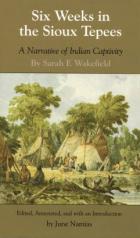
Six Weeks in the Sioux Tepees: A Narrative of Indian Captivity
|
Six Weeks in the Sioux Tepees: A Narrative of Indian Captivity
In 1862, Sarah F. Wakefield, a doctor's young wife with two small children, suddenly found herself caught up in the Dakota War in Minnesota. In a compelling voice, she relates the ordal, particularly the heroism of the Mdewakanton Dakota man Chaska (We-Chank-Wash-ta-don-pee), who protected Wakefield and her children during the upheaval only to be rewarded by the United States government with death by hanging. During ensuing investigations, Wakefield boldly held the government responsible for the war and its casualties.
June Namia's extensive introduction and notes describe the historical and ethnographic background of Dakota-whte relations in Minnesota and place Wakefield's narrative within the context of other captivity narratives. She is Associate Professor of History at the University of Alaska Anchorage.
Buy Book
|
|

Spirit Car: Journey to a Dakota Past
|
Spirit Car: Journey to a Dakota Past
A child of a typical 1950s suburb unearths her mother’s hidden heritage, launching a rich and magical exploration of her own identity and her family’s powerful Native American past.
Minnesota Book Award Winner
One day I realize that my entire back seat is filled with relatives who wonder why I’m not paying more attention to their part of the family story … Sooner or later they all come up to the front seat and whisper stories in my ear.
Growing up in the 1950s in suburban Minneapolis, Diane Wilson had a family like everybody else’s. Her Swedish American father was a salesman at Sears and her mother drove her brothers to baseball practice and went to parent-teacher conferences.
But in her thirties, Diane began to wonder why her mother didn’t speak of her past. So she traveled to South Dakota and Nebraska, searching out records of her relatives through six generations, hungering to know their stories. She began to write a haunting account of the lives of her Dakota Indian family, based on research, to recreate their oral history that was lost, or repressed, or simply set aside as gritty issues of survival demanded attention.
Spirit Car is an exquisite counterpoint of memoir and carefully researched fiction, a remarkable narrative that ties modern Minnesotans to the trauma of the Dakota War. Wilson found her family’s love and humor — and she discovered just how deeply our identities are shaped by the forces of history.
Diane Wilson is a freelance writer and editor. She lives in Shafer, Minnesota.
Buy Book
|
|
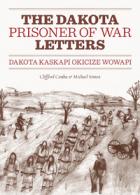
The Dakota Prisoner of War Letters: Dakota Kasapi Okicize Wowapi
|
The Dakota Prisoner of War Letters: Dakota Kasapi Okicize Wowapi
In April 1863 — after the U.S. Dakota War of 1862, after the hanging of thirty-eight Dakota men in the largest mass execution in U.S. History — some 270 Dakota men were moved from Mankato, Minnesota, to a prison at camp McClellan in Davenport, Iowa. Separated from their wives, children, and elder relatives, with inadequate shelter, they lived there for three long, wretched years. More than 120 men died. Desperate to connect with their families, many of these prisoners of war learned to write. Their letters, mostly addressed to the missionaries Stephen R. Riggs and Thomas S. Williamson, asked for information, for assistance, and for help sending and receiving news of their loved ones.
Dakota elders Clifford Canku and Michael Simon, fluent Dakota speakers, provide both the Dakota transcription and the first published English translation of fifty of these letters, culled from Riggs’s papers at the Minnesota historical society. They are a precious resource for Dakota people learning about the travails their ancestors faced, important primary source documents for historians, and a vital tool for Dakota language learners and linguists.
These haunting documents present a history that has long been unrecognized in this country, in the words of the Dakota people who lived it. The dedication written by the authors, both of whom are descendents of Dakota prisoners of war, declares: “Our relatives are watching over us. / We are humbled as we honor our ancestors. / Woecon kin de unyakupi do / We accept this responsibility you gave us.”
Dr. Clifford Canku is an assistant professor of Dakota studies at North Dakota State University. Michael Simon is an instructor of Dakota language for the Moorhead (Minnesota) Public Schools. Both are retired Presbyterian ministers and enrolled members of the Sisseton Wahpeton Oyate.
Buy Book
|
|
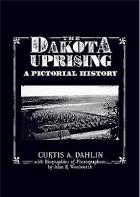
The Dakota Uprising - A Pictorial History
|
The Dakota Uprising - A Pictorial History
A vivid and intimate portrait of Minnesota's 'war within' during the period of the Civil War.
The Dakota Uprising of 1862 was the most significant event in Minnesota's history. It was catastrophic in nature, and it profoundly affected all parties involved — white settlers, hostile Dakota, and friendly Dakota. It also significantly affected the Winnebago, who had very limited involvement in the Uprising. Most of the affected white settlers lived on homesteads or in towns located near the Dakota Reservation along the Minnesota River. They received the brunt of the Dakota assaults. This book contains many observations by Henry H. Sibley and Stephen R. Riggs. Riggs was a longtime missionary to the Dakota, and accompanied Sibley during much of the Uprising. Both men played a central role in the events of the Uprising and, even more importantly, they documented those observations in numerous contemporary letters and reports. Their witness of events is indispensable in relating the story of the Uprising.
Curtis Dahlin has put a face on the events of the Dakota Uprising, in fusing together hundreds of rare period photographs and an absorbing narrative, brings us a vivid and intimate portrait of Minnesota's 'war within' during the period of the Civil War.
Curtis Dahlin, an independent historian specializing in the Dakota Uprising of 1862 in Minnesota, has spent thousands of hours and driven many thousands of miles researching and writing about the subject. In 2007, he published Dakota Uprising Victims: Gravestones & Stories. Previously, in 2001, he participated in compiling and writing Joel E. Whitney, Minnesota's Leading Pioneer Photographer, and in 2008, he wrote an essay for Trails of Tears: Minnesota's Dakota Indian Exile Begins. He and his wife, Gay, live in Roseville, Minnesota.
|
|
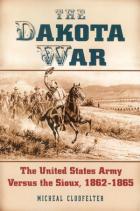
The Dakota War: The United States Army Versus the Sioux, 1862-1865
|
The Dakota War: The United States Army Versus the Sioux, 1862-1865
As the United States fought the Civil War in the early 1860s, the country's western frontier was simultaneously the site of significant and deadly military campaigns. The Dakota campaign against the Sioux was greater in scope, intensity and bloodshed than almost all other Indian battles fought in the West.
The Minnesota War of 1862 and the Dakota War of 1863-1865 were significant U.S. victories, but did not temper the passions of the Sioux to preserve their people and land or the desires of the whites to settle the frontier. The wars pushed the Teton Sioux into a long-term resistance that would end only at Wounded Knee in 1890.
Micheal D. Clodfelter, a Vietnam veteran, has also written Warfare and Armed Conflicts: A Statistical Reference to Casualty and Other Figures, 1500-1999 (2d ed., 2002) and Vietnam in Military Statistics (1995). He lives in Lawrence, Kansas.
|
|
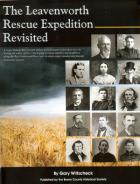
The Leavenworth Rescue Expedition Revisited
|
The Leavenworth Rescue Expedition Revisited
An account of how a rescue party left the safety of New Ulm hoping to rescue families and neighbors along the Big Cottonwood River, only to return empty-handed and placing themselves in peril. Numerous maps and black & white photograph, with survivor accounts and quotations from newspapers of the time.
|
|
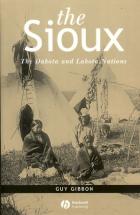
The Sioux: The Dakota and Lakota Nations
|
The Sioux: The Dakota and Lakota Nations
A valuable starting point for readers interested in Sioux history and culture. The rich history and diversity of Sioux culture, from prehistory to the present day, with lessons in cross-cultural understanding.
|
|
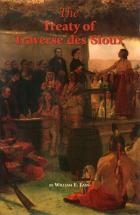
The Treaty of Traverse des Sioux
|
The Treaty of Traverse des Sioux
This book places the 1851 Treaty of Traverse des Sioux within the broad framework of state and national history.
In 1851 the Sisseton and Wahpeton bands of the Dakota Indians signed the Treaty of Traverse des Sioux, which along with the subsequent Treaty of Mendota, with the Mdewakanton and Wahpekute bands of Dakota, ceded to the United States most of southern and central Minnesota.
This study considers the national and regional background of the Treaty of Traverse des Sioux, the treaty's negotiation, provisions and implementation, and its legacy. A verbatim copy of the treaty is included in the appendix.
Dr. William Lass, History Professor Emeritus at Minnesota State University, taught Minnesota History for over 40 years and published many books, articles, and book reviews throughout his career.
Buy Book
|
|
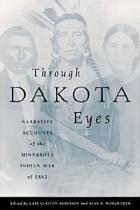
Through Dakota Eyes: Narrative Accounts of the Minnesota Indian War of 1862
|
Through Dakota Eyes: Narrative Accounts of the Minnesota Indian War of 1862
This collection of thirty-six narratives presents the Dakota Indians' experiences during a conflict previously known chiefly from the viewpoints of non-Indians.
"This volume brings together an invaluable collection of vivid eyewitness accounts of the Minnesota Indian War of 1862 and its aftermath. Of greatest interest is the fact that all the narratives assembled here come from Dakota mixed-bloods and full-bloods. Speaking from a variety of viewpoints and enmeshed in complex webs of allegiances to Indian, white, and mixed-blood kin, these witnesses testify not only to the terrible casualties they all suffered, but also to the ways in which the events of 1862 tore at the social, cultural, and psyhic fabrics of their familial and community lives. This rich contribution to Minnesota and Dakota history is enhanced by carefull editing and annotation." — Jennifer S. H. Brown, University of Winnipeg
Praise for Through Dakota Eyes
"For anyone interested in Minnesota history, Native-American history, and Civil War history in this forgotten theater of operations. Through Dakota Eyes is an absolute must read. …an extremely well-balanced and fascinating book that will take it's place at the forefront of Indian Historiography." — Civil War News
"An important look at how the political dynamic of Minnesota's southern Dakota tribes erupted into a brief, futile blood bath. It is also a vital record of the death song of the Dakota's traditional, nomadic way of life." — Minnesota Daily
"An appreciation for the diversity and complexity of Dakota culture and politics emerges from Through Dakota Eyes. … captures some of the human drama, tragedy, and confusion which must have surely characterized all American frontier wars." — American Indian Quarterly
Buy Book
|
|
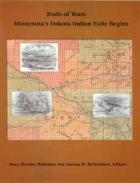
Trails of Tears: Minnesota's Dakota Indian Exile Begins
|
Trails of Tears: Minnesota's Dakota Indian Exile Begins
The Dakota War of 1862 was a tragedy for both the white settlers on Minnesota's frontier and the Dakota Indians. This book, through a series of essays, centers on the beginning of the post-war exile of the Dakota people from Minnesota. The authors have compiled an intriguing and objective look at aspects that have never before been thoroughly explored or published.
Interest in the topic sprang from the biennial Commemorative Marches sponsored by members of the Dakota community, the sesquicentennial of Minnesota's statehood and the coming sesquicentennial of the Dakota War itself. The painful and complex series of events unfolded from the defeat of Chief Little Crow's forces at Wood Lake through the military excort of the prisoners to South Bend near Mankato and the families to Fort Snelling. The public outcry to rid the state of the Indians put the Dakota people at risk, and plots of local mobs to massacre them were covered up at the highest level of the state government.
This book looks at the preparations and actions taken by General Sibley's army, the two distinct routes it used to escort the Indians (including evidence of the actual route taken by the families), the political climate, details of the plots, how the narratives have evolved over the years, and insight into the plight of individual Dakota families. In short, it illuminates the human tragedy of the story: the seeming inability of people on either side to respect their common humanity.
|
|
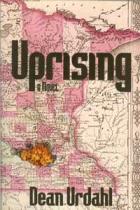
Uprising 1: A Novel
|
Uprising 1: A Novel
A fictional account full of historical detail of the Civil War and the Dakota Conflict.
Dean Urdahl taught American History for thirty-five years at New London-Spicer Middle School in New London, and in 2002 was elected as a member of the MN State House of Representatives.
|
|
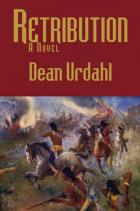
Uprising 2: Retribution
|
Uprising 2: Retribution
On August 17, 1862, four young Dakota men — hungry and resentful over broken treaties, unkept promises, and mistreatment — had murdered five white settlers near Acton in central Minnesota. This novel asks the questions how many were killed, how many had left never to return, and what would be done in retribution?
|
|
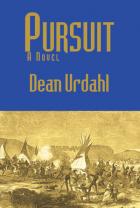
Uprising 3: Pursuit
|
Uprising 3: Pursuit
Part three of a historical fiction trilogy set in Minnesota during the U.S. Dakota War of 1862.
|
|
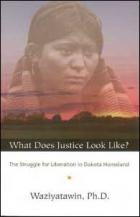
What Does Justice Look Like?: The Struggle for Liberation in Dakota Homeland
|
What Does Justice Look Like?: The Struggle for Liberation in Dakota Homeland
In this book, the difficult subject of genocide and other historic harms is addressed in uncompromising terms, as Waziyatawin, a noted Dakota scholar and activist, relates the history of her People before European arrival,and the often violent and traumatic history since that time. From that point, she proceeds to describe measures that could begin to "make things right" and make peaceful co-existence possible.
|
|
|
 Permissions beyond the scope of this license may be available at Copyright and Use Information.
Permissions beyond the scope of this license may be available at Copyright and Use Information.